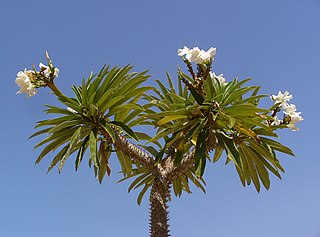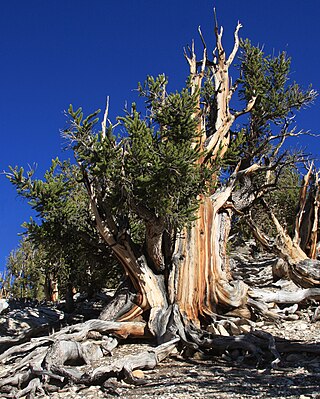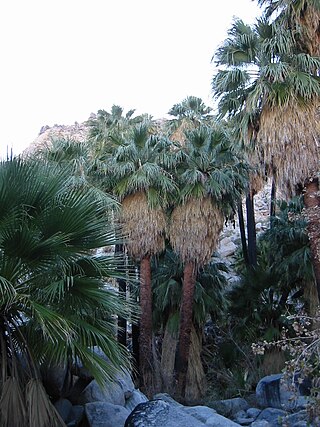
Pachypodium lamerei is a species of flowering plant in the family Apocynaceae. It is a stem succulent, photosynthesizing mainly through its trunk, and comes from the island of Madagascar, off the east coast of Africa. It has large thorns and leaves mostly just at the top of the plant, and large, fragrant flowers. The species has become one of the best known pachypodiums in cultivation, being relatively easy to propagate and grow. In cultivation it is often marketed as the Madagascar palm, despite its not being a palm at all. A variety called "Ramosum" has been described. It is distinguished mostly by a dwarf growth habit and its more rounded corolla lobe.

The tree line is the edge of a habitat at which trees are capable of growing. It is found at high elevations and high latitudes. Beyond the tree line, trees cannot tolerate the environmental conditions. The tree line is sometimes distinguished from a lower timberline, which is the line below which trees form a forest with a closed canopy.

Pinus longaeva is a long-living species of bristlecone pine tree found in the higher mountains of California, Nevada, and Utah. Methuselah is a bristlecone pine that is 4,855 years old and has been credited as the oldest known living non-clonal organism on Earth. To protect it, the exact location of this tree is kept secret. In 1987, the bristlecone pine was designated one of Nevada's state trees.

The San Jacinto Mountains are a mountain range in Riverside County, located east of Los Angeles in southern California in the United States. The mountains are named for one of the first Black Friars, Saint Hyacinth, who is a popular patron in Latin America.

Ficus microcarpa, also known as Chinese banyan, Malayan banyan, Indian laurel, curtain fig, or gajumaru (ガジュマル), is a tree in the fig family Moraceae. It is native in a range from China through tropical Asia and the Caroline Islands to Australia. It is widely planted as a shade tree and frequently misidentified as F. retusa or as F. nitida.

Trachycarpus fortunei, the Chinese windmill palm, windmill palm or Chusan palm, is a species of hardy evergreen palm tree in the family Arecaceae, native to parts of China, Japan, Myanmar and India.

Washingtonia filifera, the desert fan palm, California fan palm, or California palm, is a flowering plant in the palm family Arecaceae, native to the far southwestern United States and Baja California, Mexico. Growing to 15–20 m (49–66 ft) tall by 3–6 m (10–20 ft) broad, it is an evergreen monocot with a tree-like growth habit. It has a sturdy, columnar trunk and waxy, fan-shaped (palmate) leaves.

Coccothrinax is a genus of palms in the family Arecaceae. There are more than 50 species described in the genus, plus many synonyms and subspecies. A new species was described as recently as 2017. Many Coccothrinax produce thatch. In Spanish-speaking countries, guano is a common name applied to Coccothrinax palms. The species are native throughout the Caribbean, the Bahamas, extreme southern Florida and southeastern Mexico, but most of the species are known only from Cuba.

Zombia antillarum, commonly known as the zombie palm, is a species of palm tree and the only member of the genus Zombia. It is endemic to the island of Hispaniola in the Greater Antilles. Usually found in dry, hilly areas of northern and southern Haiti and the northwest of the Dominican Republic, Z. antillarum is a relatively short fan palm with clustered stems and a very distinctive appearance caused by its persistent spiny leaf sheaths. Threatened by habitat destruction in Haiti, Z. antillarum is a popular ornamental species due to its distinctive appearance, low maintenance requirements and salt tolerance.

Hedyscepe canterburyana, the big mountain palm or umbrella palm, is the sole species in the genus Hedyscepe of the family Arecaceae. It is endemic to Lord Howe Island, Australia and is threatened by habitat loss. It is a solitary palm with a distinct crownshaft, and bears unisexual flowers of both sexes. With the Rhopalostylis palms of Norfolk Island and New Zealand it forms the botanic subtribe Rhopalostylidinae. If differs from Rhopalostylis in minor floral details including having more than six stamens, and in being protandrous rather than protogynous. The two genera were formerly included in Archontophoenicinae until a recent revision. In some molecular phylogenetic analyses, Hedyscepe was found to be nested in the New Caledonia endemic Basselinia.

Livistona tahanensis is a species of medium-sized palm tree of the genus Livistona, found on only one mountain top in Pahang, Peninsular Malaysia. In Malay the palm is known as Tahan serdang, or as daun tau.

Roscheria is an endangered, monotypic genus of flowering plant in the palm family. The genus is named for Albrecht Roscher, a 19th-century German explorer, and the epithet for its single species R. melanochaetes derives from Latin and Greek meaning 'black' and 'bristle', alluding to the spines covering the trunks. They naturally occur on the Mahé and Silhouette Islands of Seychelles where they grow in mountainous rainforest and are threatened by habitat loss.

Bismarckia is a monotypic genus of flowering plant in the palm family endemic to western and northern Madagascar, where it grows in open grassland.

Chamaedorea elegans, the neanthe bella palm or parlour palm, is a species of small palm tree native to the rainforests in Southern Mexico and Guatemala. The parlor palm is one of the most extensively sold houseplant palms in the world. It is one of several species with leaves that are harvested as xate.

Lepidorrhachis is a monotypic genus of flowering plant in the palm family restricted to Lord Howe Island. The genus name for the single, monoecious species, Lepidorrhachis mooreana, comes from two Greek word meaning "scale" and "rachis", and the epithet honors Charles Moore, first director of the Sydney Botanical Gardens. The common name is Little Mountain Palm.

Leucothrinax morrisii, the Key thatch palm, is a small palm which is native to the Greater Antilles, northern Lesser Antilles, The Bahamas and Florida and the Florida Keys in the United States.
Trees have a wide variety of sizes and shapes and growth habits. Specimens may grow as individual trunks, multitrunk masses, coppices, clonal colonies, or even more exotic tree complexes. Most champion tree programs focus finding and measuring the largest single-trunk example of each species. There are three basic parameters commonly measured to characterize the size of a single trunk tree: tree height measurement, tree girth measurement, and tree crown measurement. Foresters also perform tree volume measurements. A detailed guideline to these basic measurements is provided in The Tree Measuring Guidelines of the Eastern Native Tree Society by Will Blozan.

Thrinax radiata, also known as the Florida thatch palm, is a medium to slow growing palm in the family Arecaceae. It is native to many Caribbean islands, Mexico, Central America, and far southern Florida. Its natural habitat is sandy, calcareous soil in coastal areas.

Hemithrinax compacta is a species of palm that is endemic to Cuba.


















